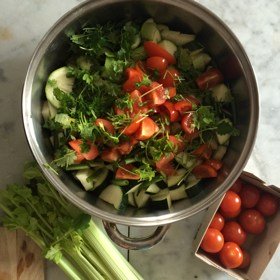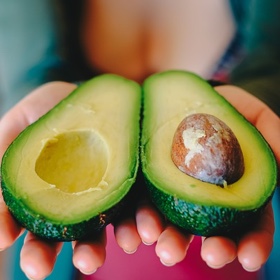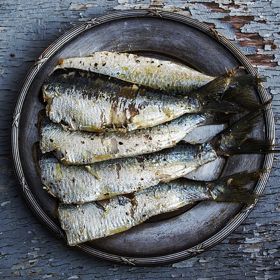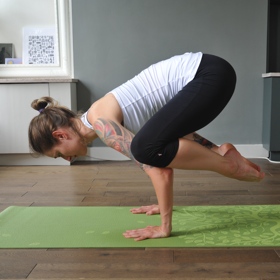
Resident Nutritionist, Michelle McKenzie at Shine, Church Street, gives us her Top 10 Tips for Nutritional Health.
Dietary advice is everywhere and what’s healthy and good for us one minute seems to change to unhealthy the next. We are being bombarded with the latest must have ‘superfoods’ and a continuous stream of fad diets that promise to help us lose weight easier and faster than ever before. The media love a good headline, it sells papers, so they tend to sensationalise an element of the latest nutritional study without fully scrutinising the research thoroughly. This leaves us skim-reading the headlines and thinking ‘oh crikey, no more coffee, cheese or fat for me!’
Healthy eating has got complicated and it really doesn’t have to be. Unless you have a pre-existing condition or allergy and require a more personalised diet, here are my top ten nutritional tips that will assist with weight goals, heal and nourish your body, and increase your energy levels. I don’t believe in a ‘one diet fits all approach’ as everyone is biologically different. However, these tips are a wonderful foundation that most ‘diet camps’ would agree with.
 1. Eat Real Food
1. Eat Real Food
Think of food as information. Every single bite either feeds or fights disease. We can literally either upgrade or downgrade our cell biology with every meal. Let’s stop focusing on calories and focus on food quality rather than quantity. Eat nutrient dense real food and avoid processed foods and drinks. Aim for quality proteins, fats and carbohydrates. If you find yourself in a shop reading the ingredients on the packet – the chances are after the fourth ingredient, it isn’t real food. Real food isn’t usually found in a packet with a list of ingredients, that’s a processed food. Real food can be found in the vegetable, fruit, dairy, fish and meat sections.
 2. Try Intermittent Fasting
2. Try Intermittent Fasting
We are living in an environment where we feel the need to be constantly grazing, never giving our digestive system or pancreas a break. Stop snacking and try some fasting instead.
Some of the many benefits of intermittent fasting include weight loss, improvements to insulin sensitivity, a boost to good bacteria and reduction in bad bacteria, improves brain function, fights cancer cells, improves fatty liver, improves cellular regeneration and repair, and reduces inflammation.
Try some time restricted eating and fast for 12 – 14 hours a day. Dinner to breakfast is the easiest as you’re sleeping most of the time, from 7pm to 7 – 9am with no snacking in between.
Stick with water, herbal tea, black tea and coffee outside your eating window.
3. Balance your Blood Sugar
The need to balance blood sugar isn’t reserved for those with metabolic conditions like diabetes. Everyone needs to be conscious of it. Getting off the blood sugar roller-coaster will have a positive effect on blood glucose, weight, energy levels and mood. It will also help to prevent weight gain, the onset of type 2 diabetes, some forms of cancer, cardiovascular disease, hypertension and research is now suggesting dementia. The easiest way to do this is to reduce your refined carbohydrate (pasta, cereals, rice, bread, crackers) and sugar intakes.
Another great reason for taking out refined carbohydrates is that it will encourage you to fill your plate with more nutrient dense foods such as vegetables, fat and healthy protein.
4. Eat Quality Protein
Dietary protein spans well beyond energy, satiety and building muscles. It plays a crucial role in just about every single bodily function.
Humans require a core group of 20 amino acids however 9 – the essential amino acids – cannot be synthesised by the body and need to be sourced through diet. Foods that provide all 9 essential amino acids are also known as complete proteins. Individuals can obtain the essential amino acids from eating small amounts of animal protein.
Vegetarians and vegans have to work at bit harder to ensure that they are getting all the essential proteins, despite meeting overall protein requirements. When following a plant based diet, aim to eat a wide variety of plant foods throughout the day. Rich protein sources include quinoa, soy (tempeh, natto, tofu) and buckwheat. If you also include plenty of pulses, dark green vegetables, hemp seeds, chia seeds, nuts and spirulina then all the essential amino acid requirements can be met. Quorn products also provide protein but it’s best not to rely on the processed meat substitutes as they are not the healthiest of options and can often contain refined seed oils, GM soya, preservatives, sugar and pesticides. Treat them like you would any other packaged processed food. Meat eaters, choose organic and sustainably raised animal products.
Include quality protein with each meal, spread intakes evenly throughout the day and aim for palm-sized portions.
 5. Fat is your Friend
5. Fat is your Friend
Enjoy lots of healthy fats. Fat is required for energy, it’s essential for brain and nerve function and needed to help absorb fat-soluble vitamins A, D, E, K, and carotenoids.
Avocados, extra virgin olive oil, full fat diary, grass-fed meat, fish, butter and nuts are all great sources of healthy fats. Include foods rich in omega-3 which you will find in fish (mackerel, salmon, herring, tuna, trout, sardines and anchovies), seeds (chia, pumpkin, flax, hemp), walnuts, seaweed, grass-fed meat and eggs.
Cut out any processed foods that contain added ‘bad’ fats.
6. Look after your Gut
As well as metabolising food and nutrients and excreting waste, 80% of our immune system is housed in our gut. 90% of the bodies serotonin (the happy hormone) is produced there and it is home to 100-trillion micro-organisms. The overall health of our gut is said to influence our wellbeing from obesity and other metabolic conditions to skin disorders, anxiety and depression.
The survival and health of our beneficial probiotic bacteria is heavily influenced by our diet with specific foods affecting  different types of bacteria. It’s probably no surprise that the foods that disrupt the microbiome are processed foods which are high in sugar, contain artificial sweeteners, refined seed oils, additives, emulsifiers, pesticides, GMO’s and antibiotic residues that have been used in food production.
different types of bacteria. It’s probably no surprise that the foods that disrupt the microbiome are processed foods which are high in sugar, contain artificial sweeteners, refined seed oils, additives, emulsifiers, pesticides, GMO’s and antibiotic residues that have been used in food production.
Diversity is important in both the food we eat and the microbes we feed so aim to incorporate a wide variety of prebiotic fibre and probiotic bacteria. The microbiome love and thrive on foods rich in prebiotic fibres, such as asparagus, Jerusalem artichokes, leeks, onions and flax seeds. Probiotic foods include kefir, kombucha, aged cheeses, fermented miso, fermented vegetables and full fat plain yogurt.
For further reading on what foods are best please check out my article on gut health.
7. Reduce Inflammation
 With inflammation cited as the driver behind most diseases today, keep inflammation at bay by including lots of blueberries (frozen are great too), extra virgin olive oil, fatty fish (salmon, mackeral, sardines) garlic, ginger, turmeric, tomatoes, beetroot, broccoli, peppers, lions mane mushrooms, green tea, bone broth and foods rich in omega 3.
With inflammation cited as the driver behind most diseases today, keep inflammation at bay by including lots of blueberries (frozen are great too), extra virgin olive oil, fatty fish (salmon, mackeral, sardines) garlic, ginger, turmeric, tomatoes, beetroot, broccoli, peppers, lions mane mushrooms, green tea, bone broth and foods rich in omega 3.
Omega 3 is anti-inflammatory and is reported to help reduce the risk of some chronic diseases (cardiovascular disease, arthritis) and play a role in maintaining eye health and heart health (blood pressure, triglyceride levels, inflammation, blood clots). It is also suggested that individuals who consume omega 3 regularly are less likely to be depressed or anxious and that adequate intakes can help fight certain types of cancer and help reduce age related mental decline such as Alzheimer’s.
Try and avoid all processed seed and vegetable oils and any foods that contain them (most packaged foods) as they are pro-inflammatory and can therefore contribute to inflammation in your body.
8. Eat Organic
Choose organic and sustainably raised animal products, fruits and veggies as far as your budget stretches. Try to avoid foods that have had antibiotics, hormones, pesticides, herbicides, and GMO’s added to them. This will be healthier for you in the long run and support the welfare of the animals and our precious land.
I’ll be honest here, buying organic produce is all well and good but that doesn’t take away from the fact that it is more affordable to buy regular fruit and vegetables so what’s the best thing to do?
The amount of pesticide residue found in foods is reported to be below safety levels but it’s tricky to determine our actual exposure to harmful residues. Over a period of time (along with other environmental toxins we are exposed to daily) toxins can accumulate in our bodies and there is some evidence to suggest that this can increase our risk of several diseases including cancer.
To help you in this decision making, the environmental working group (EWG) publish a list called the ‘dirty dozen’ which are the top twelve fruits and veg that have been found to have the highest amount of pesticide residue. The list includes (in descending order): strawberries, spinach, kale, nectarines, apples, grapes, peaches, cherries, pears, tomatoes, celery and potatoes.
I’d also like to point out that eating the listed fruit and vegetables for their nutrient profiles rather than avoiding them is really important but if there are certain foods that you consume more of than others, it may be worth sourcing organic.
If you would like more information you can find it here www.ewg.org/
 9. Stay Hydrated
9. Stay Hydrated
This is a quick one – stay hydrated. Drink plenty of water and herbal teas and limit caffeine and alcohol intakes. Bring a glass of water to bed with you at night and drink it when you wake up in the morning to rehydrate after sleeping. This will help you wake up and give you a burst of energy. Most headaches are triggered due to dehydration so before you reach for the paracetamol have a glass of water.
10. Mental Wellbeing
As a nutritionist I advise clients on what they should include or omit from their diet so they can achieve their personal health goals. However, in order to really thrive we also need to address our mental health as no amount of kale and garlic will help you to be truly healthy if you carry a load of stresses around with you. Your mental wellbeing goes hand in hand with your physical wellbeing so learning how you deal with the inevitable stresses that life throws at you is also a big part of the wellbeing puzzle. Chronic ongoing stress is said to be related to approximately 80% of all GP consultations and contributes to many of the disease’s affecting society today.
When we are stressed our bodies feel like we are in danger and switches to survive state rather than thrive state. Our body activates the hormones cortisol, adrenaline and noradrenaline which puts your body into flight or fight mode. You are basically primed for danger. All day long there is a constant stream of information between your body, mind and the environment around you. Your body’s immune system is on patrol to protect you from intruders, your gut is hopeful for some healthy gut friendly food and your endocrine system is waiting on orders on what hormones needs to be released. To put it simply, your body wants to continually know, am I under threat or am I safe?
There’s lots we can do to help us deal with stress. The first step is to create a time in your day for you to do this. You just have to commit – to yourself – to feel better.
A great way of carving out some time is by getting up half an hour earlier in the day when the house is still quiet. Ease your way into the day rather than the usual mad panic we are all used to. During this first half hour do some breathing/meditation and some form of movement. Watch how this starts to transform your day.
 Take the first 10 minutes of your day to breathe properly. Breathing encourages a full oxygen exchange that’s shown to help with a variety of conditions including pain, depression or stress. Breathing consciously, deeply and slowly will start to alter your biology and encourage a thrive rather than survive state. It’s a great way of telling your brain that things are OK, even if you don’t feel they are.
Take the first 10 minutes of your day to breathe properly. Breathing encourages a full oxygen exchange that’s shown to help with a variety of conditions including pain, depression or stress. Breathing consciously, deeply and slowly will start to alter your biology and encourage a thrive rather than survive state. It’s a great way of telling your brain that things are OK, even if you don’t feel they are.
Breathe deeply through your nose and out through your mouth. Breathe in to a count of 5, hold for a count of 5 and breathe out for a count of 5 and hold for 5. Repeat J
 You can play around with the time – for example you may feel more comfortable with 4, 6 or 7 seconds per breath cycle. There are no rules, just breathe.
You can play around with the time – for example you may feel more comfortable with 4, 6 or 7 seconds per breath cycle. There are no rules, just breathe.
After breathing spend the next 20 minutes doing some form of exercise. Some people prefer yoga and some prefer high intensity workouts (press ups, start jumps etc.) or perhaps you would prefer to dance to some music.
If you would like to explore some of these tips further and get some more personalised nutritional guidance, call me or email me for a free 10 minute chat and then book an appointment and let’s do it together.





